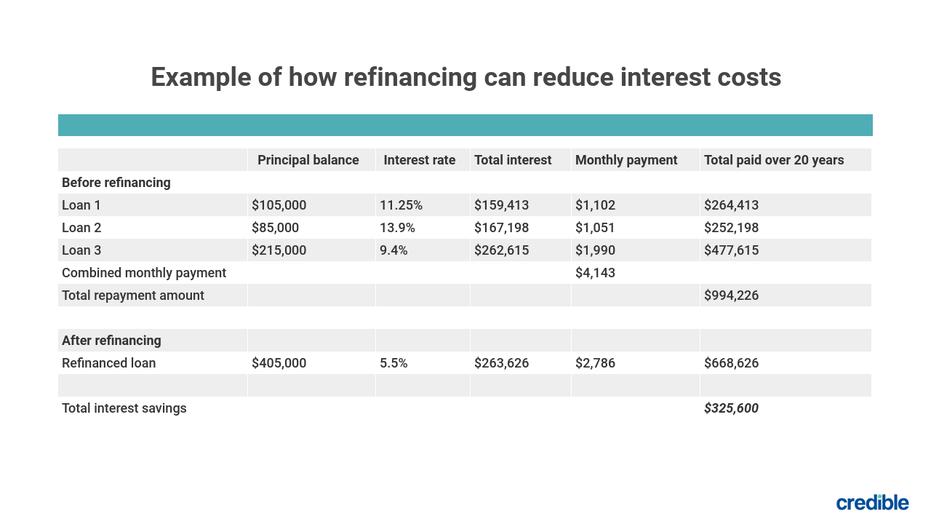5 tips for paying off $400K in student loan debt
Managing a six-figure student loan debt can be overwhelming, but federal loan programs, private options, and personal strategies can help you get out of debt sooner and for less money.

If you’re facing $400K in student loan debt, these important programs, financial products, and strategies can help you pay off those balances. (iStock)
Americans are all too familiar with student loan debt — roughly a third of adults younger than 30 carry student loan debt, according to a Pew Research Center analysis of Federal Reserve Board data. But while the average loan balance is around $31,000 for a bachelor’s degree, according to the National Center for Education Statistics, many students find themselves with six-figure debt.
This is especially true for professionals and graduate students. The average medical school graduate has $246,000 in student loans, while law school grads average $145,500, NCES data shows. And depending on the degree program and expenses, some owe significantly more.
If you’re graduating with a $400,000 student loan debt — or anywhere near that — you may feel understandably overwhelmed. But while that debt is substantial, you can take steps to pay off your debt faster and reduce your interest costs.
If you’re considering refinancing your student loans, you can compare rates from multiple lenders with Credible.
- See if you can qualify for federal student loan forgiveness
- Consider refinancing or consolidation
- Make the most of income-driven repayment plans
- Set yourself up for success with bite-size goals
- Work with the big picture
1. See if you can qualify for federal student loan forgiveness
Borrowers with six-figure student loan debt may fear that they’ll never be able to pay off their loans. And this can be a valid concern: Even before a single penny of interest is added, a $400,000 principal loan balance would mean monthly payments of $1,111 for 30 straight years.
Thankfully, some borrowers can qualify for student loan forgiveness. If you qualify, these programs can effectively wipe out a significant portion of your federal student loan debt.
Federal student loan forgiveness programs include:
- Public Service Loan Forgiveness (PSLF)
- Teacher Loan Forgiveness
- Closed school discharge
You may be required to work for a government entity, in certain low-income areas, or be employed by a qualifying not-for-profit organization, in order to get your loan forgiveness approved. You typically need to make regular on-time payments on your loans during this qualification period, as well.
It’s important to note that student loan forgiveness programs are only available for federal student loans. If you have private loans — or refinance your federal debt with a private lender — those balances will not qualify for federal forgiveness.
2. Consider refinancing or consolidation
Borrowers with multiple loans, and especially large loan amounts, may choose to consolidate and/or refinance that debt.
Consolidating federal student loans
Consolidation is offered on federal student loans at no cost to borrowers. It effectively combines multiple federal student loans into one federal Direct Consolidation Loan with a single interest rate. The fixed rate on a consolidation loan is based on the average interest rate of the loans being consolidated, so there’s no guarantee you’ll get a lower interest rate by consolidating. Consolidating will simplify your payments and may lower your monthly payments if you consolidate for a longer term. But that will extend the time it takes to pay off your debt.
Refinancing student loans
Student loan refinancing is similar, but with a few important differences. First, you can refinance multiple federal and private student loans into a single private student loan.
But if you have federal student loans and plan to take advantage of certain features (such as loan forgiveness, forbearance, or deferment), refinancing your federal debt into a private refinance loan will eliminate those benefits.
Refinancing allows you to shop around for the best interest rate available to you. Rather than your new loan’s rate being an average of the refinanced loans’ rates, this new rate will be based on your credit score and other personal factors. This has the potential to save you thousands — if not tens of thousands — of dollars over the course of your student loan repayment.
A lower rate can make it easier, and faster, to pay off your debt, even if you’re facing $400,000 in student loans.
You’ll generally need good credit to refinance your loans. Each lender will have its own requirements regarding your actual credit score, income, credit history, and loan limits. The better your credit score, the more likely you are to get approved for a lower interest rate.
You can see your prequalified student loan refinance rates in minutes when you use Credible.
How refinancing student loans can help
Here’s an example of how refinancing can help you pay off a large amount of student loan debt faster and more cheaply.
Say you have $405,000 in total student loan debt after graduation, split between three loans:
- Loan 1 — $105,000 balance, 11.25% APR
- Loan 2 — $85,000 balance, 13.9% APR
- Loan 3 — $215,000 balance, 9.4% APR
If you pay all three loans back on a schedule with 20-year loan terms, you’ll pay a combined $4,143 per month. At the end of the 20 years, with principal and interest payments considered, you’ll have paid out an astronomical $994,226 — $589,226 in interest alone.
However, if you were to refinance those three private loans into a single loan with a 5.5% interest rate, you would save a life-changing amount of money. Your initial savings alone would add up to $325,600, in fact.

To save even more, you could choose to make a larger monthly payment than is required. Let’s say you contributed $3,500 per month toward your new loan (still less than your monthly obligation on the original three loans); in this case, you’d save $90,155 over the course of your repayment and get out of debt more than six years early.
Consider using a cosigner when refinancing
If you don’t have a long enough credit history, have poor credit, or just want to get an even better interest rate, consider adding a cosigner to your refinance loan. A cosigner is someone with good to excellent credit (a parent, spouse, sibling, etc.) who agrees to share the obligation for your new loan.
In exchange, his or her credit score will impact the interest rate you’re offered. If you have a cosigner with an excellent credit history, this can unlock even lower rates and save you more.
3. Make the most of income-driven repayment plans
If you’re concerned about making the required monthly payments on large loan balances, an income-driven repayment (IDR) plan may be able to help. These plans are offered on certain federal student loans, and adjust your required minimum payments according to your current earnings and factors like family size. That way, your loan payments don’t account for too much of your annual household income.
The four primary IDRs are:
- Revised Pay As You Earn Repayment Plan (REPAYE), available on Direct Loans
- Pay As You Earn Repayment Plan (PAYE), available on Direct Loans
- Income-Based Repayment Plan (IBR), available on FFEL Program and Direct Loans
- Income-Contingent Repayment Plan (ICR), available on Direct Loans and Parent PLUS Loans
If approved for an IDR plan, your monthly loan payment on your qualifying federal student loan(s) will be adjusted according to your discretionary income. The limits vary by IDR but range from 10% to 20% of your taxable income divided by 12.
It’s important to note that signing up for an income-driven repayment plan can make monthly payments more manageable, but will extend your repayment term. This longer term will keep you in debt beyond your originally scheduled term, and will increase your interest costs.
4. Set yourself up for success with bite-size goals
If you’re juggling multiple student loans, consider how you can tackle your debt balances in a strategic way. Two options are the debt snowball method and the debt avalanche method.
Debt snowball method
The idea behind the debt snowball is to focus on one debt at a time until it’s paid off, giving you the motivation and encouragement to tackle the rest. With this method, you’ll pay only the minimum amount due on all loans except your smallest balance. That one, you aggressively attack with any and all additional funds that you have throughout the month.
Once that balance is paid, you’ll repeat the approach with the next-smallest loan balance, until all your debt is gone. This method can help you clear out individual accounts faster and for less interest.
Debt avalanche method
The debt avalanche is similar, except that you’ll focus on the loan with the highest interest rate first, rather than the lowest balance. Pay only the minimum due on all balances except that one, throwing any additional funds toward the high-rate loan. Once it’s repaid, repeat the process with the next-highest interest rate.
This method may or may not result in loans being cleared out as quickly. What it will do is aggressively reduce the total interest paid on your student loan debt.
Both the debt snowball and the debt avalanche methods can break your student loan repayment goals into manageable chunks. This can save you money, get you out of debt faster, and help you stay motivated.
You can use Credible to learn how to refinance your student loans and find an interest rate that works for you.
5. Work with the big picture
For many people, student loans are a first foray into personal debt, falling on your shoulders shortly after you reach adulthood and enter the workforce. This can make them feel very daunting, especially if you’re facing a six-figure balance.
However, these loans may also not be the only type of debt you’re facing. Mortgage loans, auto loans, personal loans, and even credit card debt may also be concerns. This is why it’s important to look at your student debt within a bigger financial picture.
Find ways to reduce your spending and put the extra money toward your debt in the most strategic way. Set a solid budget for yourself — even if it’s not much fun for a few years — and tackle your balances. If possible, look for ways to boost your income, whether that means applying for a new job, asking for a promotion, or taking on a side hustle.
Also, avoid taking on any new debt if you can. For some people, that might mean driving an older car for a few more years or even cutting up credit cards to eliminate temptation.
Paying off student loan debt can have a dramatic impact on your personal finances, as well as your credit. The sooner you can repay your balances, the better off your credit score will be and the more likely you are to get approved for better refinance loans, lower interest rates, and future financial products.